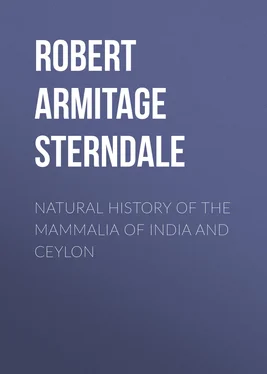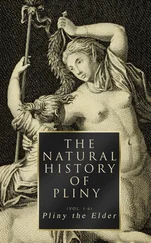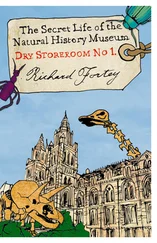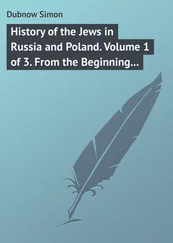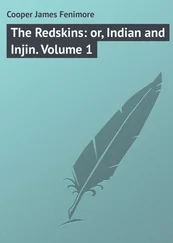Robert Armitage Sterndale - Natural History of the Mammalia of India and Ceylon
Здесь есть возможность читать онлайн «Robert Armitage Sterndale - Natural History of the Mammalia of India and Ceylon» — ознакомительный отрывок электронной книги совершенно бесплатно, а после прочтения отрывка купить полную версию. В некоторых случаях можно слушать аудио, скачать через торрент в формате fb2 и присутствует краткое содержание. Жанр: foreign_edu, Биология, на английском языке. Описание произведения, (предисловие) а так же отзывы посетителей доступны на портале библиотеки ЛибКат.
- Название:Natural History of the Mammalia of India and Ceylon
- Автор:
- Жанр:
- Год:неизвестен
- ISBN:нет данных
- Рейтинг книги:5 / 5. Голосов: 1
-
Избранное:Добавить в избранное
- Отзывы:
-
Ваша оценка:
- 100
- 1
- 2
- 3
- 4
- 5
Natural History of the Mammalia of India and Ceylon: краткое содержание, описание и аннотация
Предлагаем к чтению аннотацию, описание, краткое содержание или предисловие (зависит от того, что написал сам автор книги «Natural History of the Mammalia of India and Ceylon»). Если вы не нашли необходимую информацию о книге — напишите в комментариях, мы постараемся отыскать её.
Natural History of the Mammalia of India and Ceylon — читать онлайн ознакомительный отрывок
Ниже представлен текст книги, разбитый по страницам. Система сохранения места последней прочитанной страницы, позволяет с удобством читать онлайн бесплатно книгу «Natural History of the Mammalia of India and Ceylon», без необходимости каждый раз заново искать на чём Вы остановились. Поставьте закладку, и сможете в любой момент перейти на страницу, на которой закончили чтение.
Интервал:
Закладка:
This is also a variety of Scotophilus Temminckii .
HABITAT.—Sikim.
DESCRIPTION.—"Head and body above uniform light brown with a slight yellowish shade; underneath, from the throat to the vent, dark grey with a brownish tint, lighter on the sides of the throat. Ears long, attenuated to an obtuse point."— Jerdon .
SIZE.—Head and body, 3 inches; tail, 2 inches; expanse, 19 inches.
This bat was described by Hodgson ('Ann. Mag. Nat. Hist.' 1855), but there is some doubt about it, and it has been classed as a Lasiurus and also with Scot. ornatus and Vesp. formosa , but Jerdon thinks it a distinct species. I cannot find any mention of it in Dobson's monograph.
This is also the genus Murina of Gray. Dr. Dobson explains his acceptance of the former term in the following way: that he first accepted Murina on the score of priority in a paper showing that Harpiocephalus and Murina must be united in a single genus; but finding afterwards that Gray had founded Murina on a specimen of what he believed to be Vesp. suillus (Temm.), but which was in reality a specimen of a very different species from Darjeeling, belonging to the same section of the genus as Vespertilio harpia (Temm.) the type of his genus Harpiocephalus , it remained therefore either to discard both names or to retain Harpiocephalus , in which course he was supported by Professor Peters, to whom he mentioned the facts.
Horsfield's genus Lasiurus is included in this one, though Jerdon considers it distinct from Murina .
Muzzle elongated, conical; nostrils prominent, tubular; produced beyond the upper lip , opening laterally or sublaterally, emarginate between; crown of the head scarcely raised above the face line; ears thin, generally covered with glandular papillæ; tragus long, attenuated towards the tip, and inclined outwards; thumb very large, with a large, strongly curved claw; wings around interfemoral membrane very hairy.— Dobson .
Dentition: Inc., 2—2/6; can. 1—1/1—1; premolars, 2—2/2—2; molars, 3—3/3—3.
HABITAT.—Darjeeling and Khasia hills.
DESCRIPTION.—"Fur above very soft, silky, and rather long; colour on the head, neck, and shoulders brownish grey, with a ferruginous cast, variegated with whitish hairs; the rest of the body above, with the base of the membrane, the thighs and the interfemoral membrane, have a deep bay or reddish-brown hue, and delicate hairs of the same colour are scattered over the membrane and project from its border; the body underneath is thickly covered with a grey fur, which is paler on the breast and body; the interfemoral membrane marked with regularly parallel transverse lines" ( Horsfield ). Ears ovoid; tragus rather long, nearly straight, acute at the tip ( Jerdon ). Muzzle rather short, obtusely conical; end of nose projecting considerably beyond the lip, consisting of diverging tubular nostrils opening laterally, with a slight emargination between each ( Dobson ).
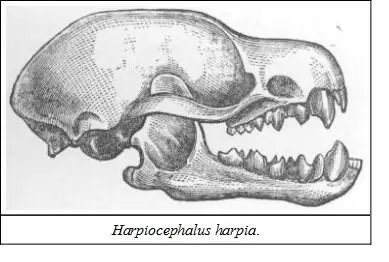
SIZE.—Head and body, 3 inches; tail, 1½ inch; expanse, 14. Hodgson, who procured it at Darjeeling, writes of it: "Entire legs and caudal membrane clad in fur like the body, which is thick and woolly. Colour bright rusty above; sooty below, the hairs tipped with hoary."
This bat is, for its size, one of the most powerfully armed with teeth. The skull reminds one of that of a dog or hyæna in miniature; the teeth are very stout, the canines blunt and conical, and the cusps of the molars short and blunt, well coated with enamel; the jaws are correspondingly muscular and adapted to the food of the animal, which consists of hard-shelled beetles, the crushed cases of which have been found in its stomach.
HABITAT.—Darjeeling ( Jerdon ); Malayan archipelago.
DESCRIPTION.—Muzzle narrow, elongated; nostrils very prominent, which, viewed from below, resemble in shape a small hour-glass placed horizontally at the extremity of the muzzle; ears moderate, shorter than the head, rounded at the tips; tragus moderately long, attenuated above and slightly curved outwards; fur light greyish-brown; extremities dark brown; beneath light greyish-brown throughout.— Dobson .
SIZE.—Head and body, 1¾ to 2 inches; tail, 1½ inch; expanse 9 to 10.
HABITAT.—Thibet.
DESCRIPTION.—Head and muzzle as in H. suillus , but the nostrils are differently shaped; each nostril forms a distinct tube directed sublaterally with a circular aperture marked by a very small notch on the outer and upper margin ( Dobson ). The whole body is thickly clad; the fur on the back is black, with bright golden yellow tips; the back of the fore-arm covered with short golden hair; the hair of the under parts black with silvery tips, whiter on the lower jaw, neck and pubis; the interfemoral membrane is covered with very long hair, which forms a fringe along its free margin extending on the legs and feet, and projecting beyond the toes; underneath short silvery hair.
SIZE.—Head and body 1·4 inch; tail 1·2.
HABITAT.—Jeripani, N.W. Himalayas.
DESCRIPTION.—Head and muzzle as in H. suillus ; fur above dark brown, with yellowish-brown extremities; beneath similar, but with the extreme points of the hairs ashy.
SIZE.—Head and body, 1·4 inch; tail 1 inch.
This bat was found near Mussoorie by Captain Hutton, who writes that it occurs, but sparingly, on the outer southern range of hills at 5500 feet. It skims close to the ground, and somewhat leisurely over the surface of the crops and grass; and one which flew into his room kept low down, passing under chairs and tables, instead of soaring towards the ceiling, as bats generally do.
HABITAT.—N.W. Himalayas, Thibet.
DESCRIPTION.—Head and muzzle as in H. harpia ; fur long and dense, above brown with grey bases; underneath whitish; sides light brown. It differs from the next species by a small projecting tooth on the inner margin of the ear conch, by the smaller size of the first upper premolar, and by the colour.— Dobson .
SIZE.—Head and body, 1·9 inch; tail 1·5.
HABITAT.—Darjeeling, Ceylon.
DESCRIPTION.—Similar to the last, but with round ears; fur bicoloured, the hairs being dark brown at the base, with bright ferruginous tips; below pale brown; the upper surface of the interfemoral membrane and back of the feet covered with hair, which also extends beyond the toes; the first premolar in the upper jaw nearly equal in size to the second, whereas in the last species it is only about three-fourths.
Читать дальшеИнтервал:
Закладка:
Похожие книги на «Natural History of the Mammalia of India and Ceylon»
Представляем Вашему вниманию похожие книги на «Natural History of the Mammalia of India and Ceylon» списком для выбора. Мы отобрали схожую по названию и смыслу литературу в надежде предоставить читателям больше вариантов отыскать новые, интересные, ещё непрочитанные произведения.
Обсуждение, отзывы о книге «Natural History of the Mammalia of India and Ceylon» и просто собственные мнения читателей. Оставьте ваши комментарии, напишите, что Вы думаете о произведении, его смысле или главных героях. Укажите что конкретно понравилось, а что нет, и почему Вы так считаете.
